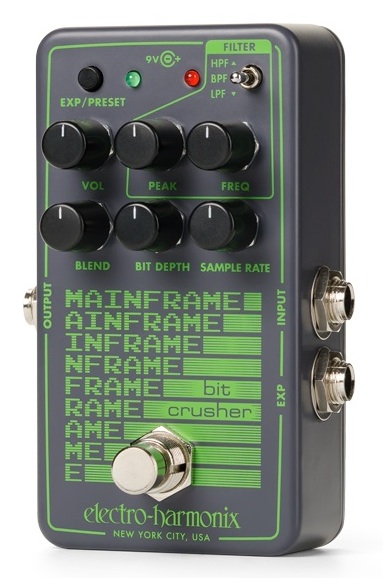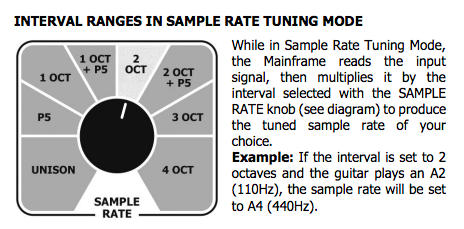New Gear Review: Mainframe Bitcrusher by Electro-Harmonix

Electro-Harmonix unleashes the Mainframe bitcrusher, featuring a handy filter section—can it earn a spot on your pedalboard?
Mangling sounds is fun. There’s no two ways about it.
Bitcrushers, in comparison to overdrives and fuzz pedals, are perhaps a less-reached-for tool when players are trying to push their signal to the next level of dirt.
Whether you’re looking to conjure a feeling of nostalgia when your biggest worry was beating the boss of Level 6 on your favorite Nintendo game, or maybe just find another fun way to rip up your signal, bitcrushers are always a fun option.
Into the bitcrusher fold comes Electro-Harmonix, a household name in guitar and bass effects. With a rich and dizzying history of iconic designs in their product lineup, they present to us the Mainframe bitcrusher pedal.
Let’s see if this little stompbox can earn a spot in your collection.
Features
For the uninitiated, bitcrushers get their sound by providing controls to reduce both the sample rate and bit depth of the incoming signal. The Mainframe features independent variable controls for each, along with a Blend knob for your wet/dry signal, and a Volume knob.
There is a filter section on the Mainframe which includes a three-way switch labeled HPF (high-pass), BPF (band-pass), and LPF (low-pass). Included in the filter section are Frequency and Peak knobs; Frequency controls your rolloff point (higher frequencies clockwise), and Peak provides a narrow EQ bump which proves useful for any of the three settings. In the case of using the band-pass filter, the Frequency knob controls the center frequency, with frequencies above and below cut.
There are three 1/4” jacks on the Mainframe: one for input, one for output, and the expression jack. In the upper left-hand corner of the Mainframe is a button labeled EXP/PRESET which turns expression mode on/off, or a saved preset on or off. (It’s worth mentioning that the Mainframe can store only one preset at a time.) It is also a winning feature that the Mainframe allows for an expression pedal to control any of its parameters.
The footswitch itself is of the soft-click variety, which is appreciated in situations such as mine where it will mostly be used for re-amping in the studio, rather than situated on a pedalboard. Double-tapping the footswitch enters Sample Rate Tuning Mode, and tapping again exits this mode with the sample rate tuning saved.
So what is Sample Rate Tuning mode?
The manual notes, “In Sample Rate Tuning Mode, the Mainframe analyzes your input signal in real-time, and sets the sample rate to match the pitch of your signal, or a set interval above your signal. You can use this mode to lock the sample rate to a certain pitch for a song, or you can keep it constantly tuning along with every note you play.”
This is an incredibly useful feature, as those who have used bitcrushers before know that certain keys, frequencies, and settings play well together in terms of pitch, while others do not.
The Mainframe’s user manual goes super in-depth with regard to expression pedal use, the saving of presets, recall, secondary knob functionality, and lots of other useful information. It is definitely worth checking out.
In line with all Electro-Harmonix offerings, the Mainframe’s physical construction feels of high quality. The knobs have just the right amount of resistance, and the innards are housed in a reassuring metal encasement, sure to withstand a beating on the road. Its gray and lime green aesthetic is resembles that of an antiquated MS-DOS command-line interface. Considering the the function of this pedal, the choice couldn’t be more appropriate. The pedal also ships with a 9.6v power supply—always appreciated.
So how does it sound?
In Use
Naturally, the first elements I planned to send through the Mainframe were guitar and bass.
My first impression of the Mainfarame’s tonality, with the filters completely open, was that there is a lot of high end to this pedal. If I had to sum up my first impression in a single word, it would be “buzzsaw”—but this is where I learned that the Mainframe’s filter plays a massive role in its sound.
As I put the pedal through its paces and ran different instruments through it, just about every instance involved the filter set to the LPF option, with the Frequency knob rolled off a bit.
It’s easy to conjure very useable settings with the Mainframe, for both bass and guitar, especially when running the signal through an amp with some gain cranked up. I find the bitcrusher and overdriven guitar or bass combination to be a pretty gnarly and unique flavor of grit.
Pushing the Sample Rate knob further and further clockwise (more reduction) produces some pretty cool sub-harmonic frequencies, and employing the filter here can create some almost synth-like tones.
Incidentally, the Mainframe can also serve as an interesting filter or EQ. If you set the Bit Depth and Sample Rate knobs fully counter-clockwise (no effect applied), and work the filter section, you can call up some pretty cool filtered sounds, especially when sweeping the Peak knob.
To Be Critical
I understand that as a producer rather than bassist or guitarist, it’s somewhat biased to fault the Mainframe for not having stereo in/out functionality, but I’d be lying if I said running a drum bus and maybe a stereo synth through it wouldn’t be super fun. That said, it’s more likely the Mainframe will be situated atop musicians’ pedalboards rather than in a producer’s crate of re-amping tricks, so I can’t fault it for that.
I also noticed that the Bit Depth control seemed to not have much of an affect from fully counter-clockwise to about 9 o’clock, then once you hit about 2 o’clock, it seems the effect here maxes out, and not much variation can then be heard from 2 o’clock to max. Most of the settings I employed had this knob situated between 9 and 2 o’clock.
Summing it Up
The Mainframe is available for $179. If you’re primarily a guitarist or bassist, I wouldn’t second guess that price of admission for a classic bitcrusher sound that is as versatile as the Mainframe. This tiny pedal is unassumingly powerful—especially when used with an expression pedal.
For producers, engineers, and other studio folk in the market for a bitcrusher, it may be worthwhile to consider a unit with stereo functionality, as any re-amping you may do through the Mainframe will have to be mono. I will certainly keep this pedal close by for any guitar, bass, and mono keyboard re-amping needs.
Please note: When you buy products through links on this page, we may earn an affiliate commission.








[…] Whether you’re looking to conjure a feeling of nostalgia when your biggest worry Read more… […]